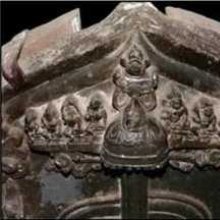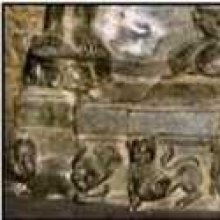Ashtadikpala, Ashta-dikpala, Aṣṭadikpāla: 6 definitions
Introduction:
Ashtadikpala means something in Hinduism, Sanskrit, the history of ancient India. If you want to know the exact meaning, history, etymology or English translation of this term then check out the descriptions on this page. Add your comment or reference to a book if you want to contribute to this summary article.
The Sanskrit term Aṣṭadikpāla can be transliterated into English as Astadikpala or Ashtadikpala, using the IAST transliteration scheme (?).
Images (photo gallery)
In Hinduism
Shilpashastra (iconography)
Source: Shodhganga: The significance of the mūla-beras (śilpa)Aṣṭadikpāla (अष्टदिक्पाल) or Aṣṭadikpālaka refers to the “eight guardians of the directions”, as defined according to texts dealing with śilpa (arts and crafs), known as śilpaśāstras.—The hand poses for the eight dikpālas (guardians of directions) are described in the Abhinayadarpaṇa and they are followed in the dance performance. But the hastas prescribed to depict the [Aṣṭadikpālaka] Gods in Abhinayadarpaṇa do not exactly look like the images of Gods found in the temples.

Shilpashastra (शिल्पशास्त्र, śilpaśāstra) represents the ancient Indian science (shastra) of creative arts (shilpa) such as sculpture, iconography and painting. Closely related to Vastushastra (architecture), they often share the same literature.
India history and geography
Source: Yale Journal of Music & Religion: Ritual Music in Contemporary Brahmanical Tantric Temples of KeralaAṣṭadikpāla (अष्टदिक्पाल) refers to the “eight regents of space” found at certain ancient temples from Kerala sanctioned by the Tantrasamuccaya.—Such temples, alternatively called kṣetras or ambalams, consist of six parts: (1) the shrine, or śrīkōvil, and (2) the pañcaprākāras, the five successive enclosures surrounding it. [...] The antarmaṇd̩ala is the innermost enclosure (prākāra). It surrounds the śrīkōvil and includes a pillared hall built in front of it and the balipīṭhas, which are stones representing the eight regents of space (aṣṭa-dikpālas) and other divinities.

The history of India traces the identification of countries, villages, towns and other regions of India, as well as mythology, zoology, royal dynasties, rulers, tribes, local festivities and traditions and regional languages. Ancient India enjoyed religious freedom and encourages the path of Dharma, a concept common to Buddhism, Hinduism, and Jainism.
Languages of India and abroad
Sanskrit dictionary
Source: Cologne Digital Sanskrit Dictionaries: Shabda-Sagara Sanskrit-English DictionaryAṣṭadikpāla (अष्टदिक्पाल).—m. plu.
(-lāḥ) The regents of the cardinal points, as Indra of the East; Vahni of the S. E.; Yama of the South; Nairrit of the S. W.; Varuna of the West; Marut of the N. W.; Kuvera of the North; and Isa of the N. E. E. aṣṭadiś the eight points, and pāla who protects.
Source: Cologne Digital Sanskrit Dictionaries: Monier-Williams Sanskrit-English Dictionary1) Aṣṭadikpāla (अष्टदिक्पाल):—[=aṣṭa-dik-pāla] [from aṣṭa-diś > aṣṭa > aṣṭan] m. [plural] the eight regents of the cardinal points, as Indra of the East, etc.
2) [v.s. ...] (See dik-pati and -pāla.)
Source: Cologne Digital Sanskrit Dictionaries: Yates Sanskrit-English DictionaryAṣṭadikpāla (अष्टदिक्पाल):—[aṣṭa-dik-pāla] (lāḥ) 1. m. Regents of the cardinal points.
Sanskrit, also spelled संस्कृतम् (saṃskṛtam), is an ancient language of India commonly seen as the grandmother of the Indo-European language family (even English!). Closely allied with Prakrit and Pali, Sanskrit is more exhaustive in both grammar and terms and has the most extensive collection of literature in the world, greatly surpassing its sister-languages Greek and Latin.
Kannada-English dictionary
Source: Alar: Kannada-English corpusAṣṭadikpāla (ಅಷ್ಟದಿಕ್ಪಾಲ):—[noun] (pl.) the chief guardians of the eight directions, (as Indra, Agni, Yama, etc.).
--- OR ---
Aṣṭadikpāḷa (ಅಷ್ಟದಿಕ್ಪಾಳ):—[noun] = ಅಷ್ಟದಿಕ್ಪಾಲ [ashtadikpala].
Kannada is a Dravidian language (as opposed to the Indo-European language family) mainly spoken in the southwestern region of India.
See also (Relevant definitions)
Partial matches: Ashtadik, Ashta, Paala, Pala, Dikpala.
Starts with: Ashtadikpalaka.
Full-text: Ashtadikpalaka, Ashta-paripalana, Dikpala, Balipitha, Antarmandala, Digishvara, Digisha, Ashapala, Nirriti, Lokapa, Lokapala, Dikpati.
Relevant text
Search found 4 books and stories containing Ashtadikpala, Astadikpala, Ashta-dikpala, Aṣṭadikpāla, Aṣṭa-dikpāla, Asta-dikpala, Ashtadik-pala, Aṣṭadik-pāla, Astadik-pala, Aṣtadikpāla, Aṣṭadikpāḷa, Aṣtadikpāḷa; (plurals include: Ashtadikpalas, Astadikpalas, dikpalas, Aṣṭadikpālas, dikpālas, palas, pālas, Aṣtadikpālas, Aṣṭadikpāḷas, Aṣtadikpāḷas). You can also click to the full overview containing English textual excerpts. Below are direct links for the most relevant articles:
Jain Remains of Ancient Bengal (by Shubha Majumder)
Ṛṣabhanātha sculptures with miniature Tīrthaṅkaras and Dikpālas < [Chapter 6 - Iconographic Study of Jaina Sculptural Remains]
Puranic encyclopaedia (by Vettam Mani)
The Linga Purana (by J. L. Shastri)
Chapter 47 - Installation of the Liṅga (continued) < [Section 2 - Pūrvabhāga]
The Brahma Purana (by G. P. Bhatt)

